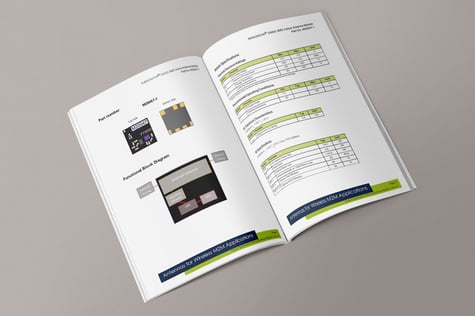Wireless technology is everywhere. The Internet of Things (IoT) has brought connectivity to a huge variety of devices. From bicycles to smart city lighting, antennas are ubiquitous – in all sorts of forms.
Typically, embedded antennas occupy a significant portion of a circuit board. Their operation relies upon ground plane space. At sub-1GHz frequencies, ground plane length is a basic requirement for the antenna to function properly. As a result, antennas cannot be shrunk in quite the same way as other components. Instead, RF engineers are beginning to manipulate the physical layout and makeup of antennas. This has created even greater diversity in the types of antennas available.
But which antenna topology will serve each application best? We’ve reviewed some of the major antenna topologies with an eye on how easy they are to integrate, and the levels of performance they deliver.
What should you consider when choosing between antenna topologies?
Space is an incredibly valuable asset on a circuit board. With this in mind, some of the most popular antennas today are available in incredibly small form factors. The nature of antennas, though, makes the choice a difficult one. There are plenty of factors to consider, including:
- The devices’ proximity to other electronics
- Where the antenna will be placed on the board
- Ground plane space
- Antenna and RF circuitry matching
- User interference
While an antenna within a smaller form factor may seem beneficial within miniature electronics, there’s much more to consider. The topology of an antenna will determine how it performs in terms of; efficiency, bandwidth, radiation pattern and gain. The smallest antenna isn’t always the best choice.
Trace Antennas
Offering unprecedented levels of control, PCB trace antennas were long considered the most appropriate choice. Not only that, but they are relatively inexpensive, and can be reproduced quickly at scale.
However, there are some discernible drawbacks of using trace antennas, including:
- They can take up as much as 10x the amount of space on a circuit board as a chip antenna. As they are purely 2D, they cannot offer the same space-saving features as a PIFA, chip or even patch.
- Detuning sensitivity. Seemingly small changes to circuit board materials or component layout can drastically detune an antenna.
- Integration difficulty. Although there are many reference designs available freely, they cannot always be optimised for your device.
Patch Antennas
In GPS applications, ceramic patch-type antennas have long been considered the best choice. However, particularly given the popularity of handhelds and wearables, their usage has diminished. This is due to a variety of reasons, which has raised questions about ceramic patch suitability in GNSS applications.
There are several concerns that arise:
- Directivity. Patch antennas are highly directional. In GPS applications, they need to be pointed upwards to the sky to function effectively.
- Cost and performance. Smaller ceramic patch antennas can be costly. However, they cannot guarantee the same levels of performance of other antenna types – simply due to the shortage of ceramic material available to transmit and receive RF energy.
- Frequencies. In small form factors, ceramic patches typically only support narrow frequency bands. Other forms of antennas can support wider frequency bands in smaller form factors.
PIFA Chips
Planar Inverted-F Antennas (PIFA) have become the de-facto wireless solution. Since being popularised in 1998, they have become ubiquitous in handhelds, wearables and small IoT devices. Their primary advantage is their small form factor and ability to deliver high levels of performance within this compact field.
This topology yields good SAR properties while being resonant at a quarter wavelength. This is made possible due to the 3D topology of the antenna.
Advantages:
- High performance in a small form factor.
- Easy to integrate, with support available for antenna integration. Circuitry matching involves a simple matching circuit.
- Widely available and relatively inexpensive.
- Available in tape-and-reel, so can be added to PCBs relatively inexpensively.
- They can be placed on top of the PCB ground plane to allow components to be placed underneath the antenna.
Considerations:
- Careful integration is required.
- Selecting a PIFA antenna takes more rigour than alternative antenna types.
Electrically Small Antennas (ESAs)
ESAs, or electrically small antennas, are antennas that are much shorter than their designated wavelength. Whereas some antennas work on ¼ or ½ of a ground plane, ESAs can be as small as 1/10th of a wavelength.
Some of the world’s first antennas used this topology. However, recent innovations have led to their performance drastically improving. Now they have far better gain, bandwidths and field pattern.
Advantages:
- Tiny, some measure less than 20 mm.
- Relatively immune to proximity and detuning effects
- Using a technique called beam steering, ESAs can scale their system capacity relatively easily.
Considerations:
- Requires considered integration to ensure high levels of performance.
Terminal antennas
In applications that require mission-critical wireless performance, terminal antennas offer opportunities to obtain the highest levels of performance. Think of medical and health monitoring equipment, eHealth devices, that require constant and reliable connectivity.
Terminal antennas can offer an appropriate solution. While they are large and extrude from a product’s housing, they offer outstanding performance in free space. As they do not need to counteract the effects of intra-device detuning or be matched to operate optimally within a device’s housing.
Magnetic loop antennas

In contrast to a monopole or dipole antenna, a magnetic loop antenna couples to the magnetic field wave in the region near the antenna. This small configuration works perfectly in ultra-small devices that require high levels of performance within a compact form.
Advantages:
- Compact. Looped antennas are highly efficient, with good performance available within a highly compact form.
- Coupling. There is reduced coupling between a loop antenna and the PCB, which in turn necessitates a smaller ground plane.
- Detuning. Magnetic loop antennas, due to their topology, are stable against de-tuning.
Due to their form, they are ideally suited for wearable and handheld devices, where PCB space is at a premium and performance is critical.
In summary
The diversity in the Internet of Things is being enabled through a mixture of antenna topologies. The variety of antennas are enabling devices in all sorts of applications and markets to launch, offering new ways of adding value through wireless connectivity.
PIFA is the most popular topology in this era, thanks to their small form factor and ability to offer high levels of performance. Trace antennas are still popular, due to the flexibility and low cost they offer to those comfortable with designing them. Patch antennas are not as widely used as they once were, due to their directivity and cost, but are still useful in parallel-to-the-sky applications like drones and connected vehicles. Terminal antennas are still preferred in applications where continuous, uninterrupted technology is critical. Innovations like case-mounted isolated antennas are also enabling connectivity in bicycles and devices with metallic product casings.
The sheer variety of choice makes the selection of an antenna all the harder. But it also means that wireless performance can be improved by simply choosing the right antenna. Antenova offers antennas in a variety of topologies, all designed with easy integration in mind. If you are selecting an antenna for an IoT project, then browse our range of antennas based on technology, or download our ‘Wireless Antennas Compared’ guide for more information.




